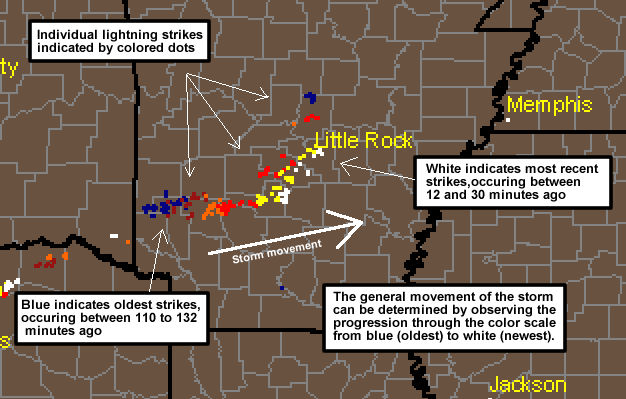Decoding Guide
Lightning Data Tutorial
Abstract:
This chart depicts the location of recent cloud-to-ground lightning strikes.Description:
This product depicts the locations and age of recent lightning strikes. The data originates from land-based strike sensors located throughout the U.S. Note that this image portrays 90% of cloud-to-ground strikes.Issuance:
Continuously—The image is updated every 10 minutes. All strikes portrayed are a minimum of 12 minutes old at the time of posting.Data Sources:
Ground-based lightning detector network (USPLN).Depiction:
Each strike is depicted by a solid square symbol. The age of the strike is depicted by changing the color of the symbol. After 132 minutes, the strike is removed from the map.Color code:

Example:

How it works:
When a lightning strike occurs a burst of energy is transmitted through the atmosphere much like a radio wave from a transmitter. Unlike a radio wave, however, lightning energy is not well ordered and spreads out across many different EM wavelengths.Lightning detectors work much like a AM radio receiving signals from a tower. The detector contains special equipment that allows it to determine what direction, relative to the detector, the lightning strike occurred. The detector notes the polarity, amplitude, and exact time of the strike (determined by an extremely precise, GPS synchronized clock), then transmits that information back to a central hub. The detectors can detect strikes hundreds or even thousands of miles away. Inevitably a strike within the coverage area will be detected by multiple receivers, all of which transmit the strike data and time back to the hub.
Computers at the hub examine the incoming data and correlate strikes based on time and location. By using triangulation methods from the multiple detections, the hub can determine the precise location (down to 250 meters) where the strike occurred.
Data for all detected strikes are collected and transmitted from the lightning data collection hub to the WeatherTAP Data Center. The WeatherTAP Data Center continuously accumulates the data and renders a new lightning strike image every 10 minutes.
